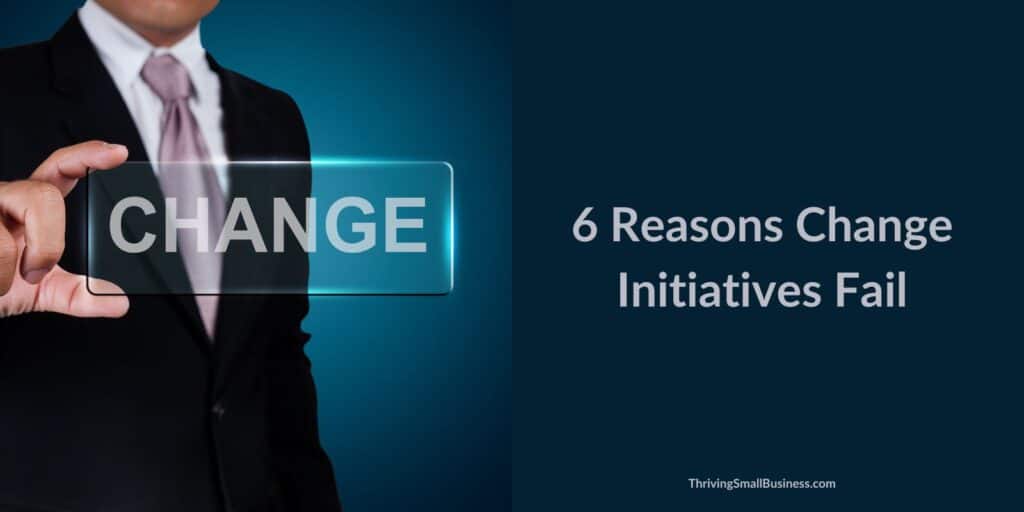6 Reasons Change Initiatives Fail
Estimated reading time: 5 minutes
The business world is changing. Artificial Intelligence has disrupted how work gets done. Despite low unemployment, businesses must stay competitive by embracing these new technologies and improving internal processes.
This means organizations need to look at their business practices and consistently evaluate how they do what they do. And how new tools can help them!
Organizations that incorporate change into their day-to-day operations are more likely to succeed than those that merely “react” to problems.
Think about it: does your car do better when you maintain it regularly or when you wait for it to break down?
What Drives Change Efforts?
Change can be driven by things that are going on within an organization (growth, budget cuts, product line changes) or things that happen outside the organization (customer expectations, market changes, artificial intelligence, etc).
As organizations grow, change comes naturally through strategic initiatives that dictate how the organization does what it does.
For example, a small candle-making business may operate out of someone’s basement when the business starts, but as it grows, there may be a need to look for space to create assembly lines. This would be a major change.
Change is Difficult
Change can be difficult for people because, as humans, we are creatures of habit, and change can upset routines and processes and sometimes requires relearning how to do things.
People resist change because there is the fear of the unknown.
This can create conflict and fear in the workplace.
It is important to have a process to manage the change to ensure the transition goes as smoothly as possible.
Part of that process is communication.
Clear communication is imperative all the time but particularly during times of change.
Create structured communication processes that help to minimize uncertainty and the fear associated with change.
Change Agent
Organizations that strive to improve and embark on a major change initiative will often assign a person to be what is called a change agent.
Change agents are used to facilitate the change process by managing the change and ensuring good communication throughout the process.
A change agent can be someone within the organization or they can be someone from outside the organization.
This person may have specialized training in organizational behavior and can help guide and advise the change process.
External Change Agents
Change agents from outside an organization may be challenged with building relationships and becoming familiar with organizational “norms,” beliefs, and accepted behaviors.
Outside change agents are not as tied to traditions within an organization so that they may challenge the status quo.
The advantage of using an outside change agent is their objectivity and the ability to give honest feedback to management without fear of reprisal.
They also bring perspectives from other organizations, so they share a broad range of experiences.
The disadvantage of using an external change agent is that they don’t have a working knowledge and understanding of the company culture.
The other disadvantage is the organization’s ability to maintain momentum after the change agent leaves.
Internal Change Agent
Internal change agents have advantages in that they have a working understanding of the organization regarding people, culture, behavioral norms, etc.
Their difficulty comes with their credibility and their ability to change something that is already in motion.
It takes a skilled person to take on the role of an internal change agent.
Regardless of the model you choose, change can be a difficult thing and, if not done right, can fail – often miserably.
6 Reasons Change Initiatives Fail
1. Lack of Leadership Support
Change without leadership support is destined to fail.
Any change initiative must be supported at the highest level of leadership within the organization.
Employees will notice and not take it seriously if management isn’t completely engaged in the effort.
The more front-line employees hear ‘the big bosses’ talk about the change, the more likely they will embrace and support it.
2. Insufficient Resources
Most change initiatives require a certain level of resources – people, time, or money.
Whether it is a budget for new equipment, a person to lead the charge, or time allocated to training employees, resources must be allocated and assigned to the effort.
There are not many things more frustrating for employees than to be given a task without adequate resources to pull it off.
3. Poor Planning and Implementation
What is the old saying, “if you fail to plan, you plan to fail”.
This can be applied to all areas of life and business, but the detail in planning an organizational change is critical.
Think through and strategize for every aspect of the change to minimize potential issues that inevitably arise during implementation.

For instance, if you plan to expand your facility and move offices for support staff.
Take the time to plan for office furnishings, computer hookups, and phone systems so that the new work area is set up and ready to use on the day of the move.
4. Poor Communication and Buy-in
I always say that wars are fought because of poor communication, and a change effort is no different.
Organizations struggle with change initiates when they fail to get the employees involved and behind the change.
Employee buy-in can always be attributed to a compelling vision for change and consistent communication throughout the process.
5. Priority
It is a sad fact, but many organizations have very real issues with attention deficit.
A good idea gets a lot of attention when it is first being discussed, but it is easy to lose focus once the rubber meets the road.
Losing a priority status can quickly kill a change initiative.
6. Inadequate Adjustment Period
Sometimes, organizations don’t give a change initiative enough time to take root before they kill the effort.
Learning new processes and changing them to organizational norms takes time.
Regardless of whether an internal or external change agent is chosen, the most critical aspect of change initiatives is the organization’s ability to drive the change through a clear vision, support, focus, and communication.
What changes are your organization tackling?






